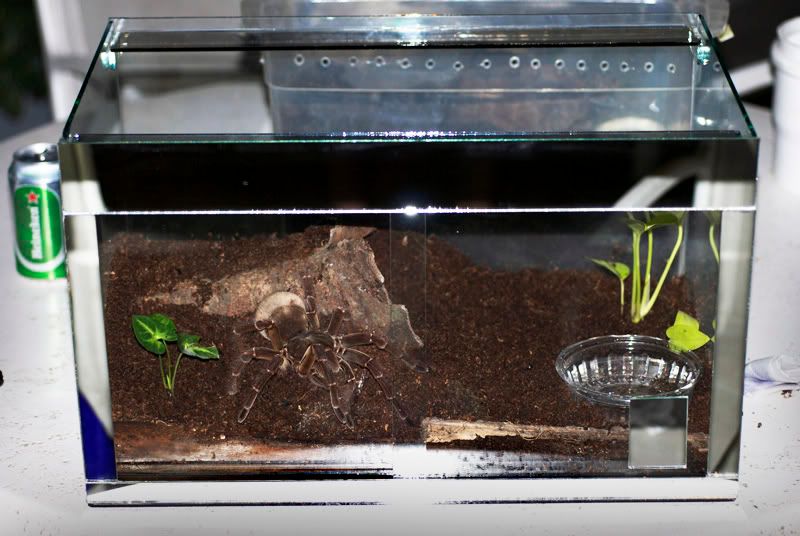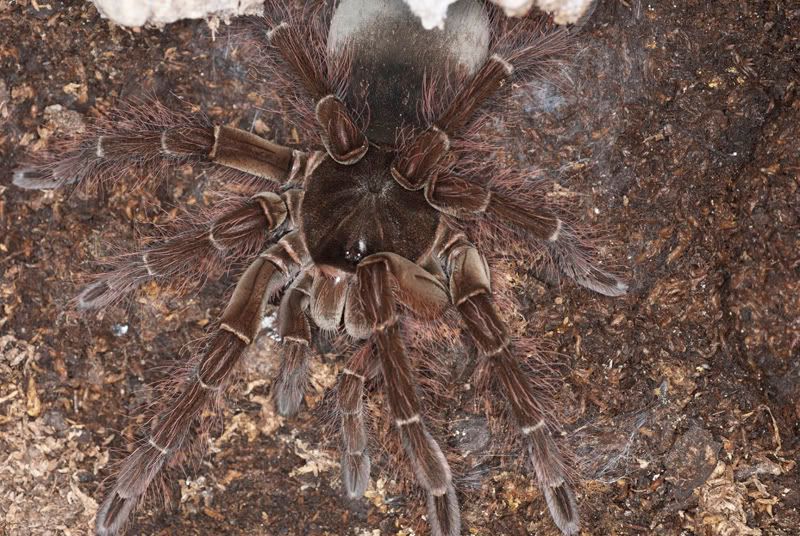- Joined
- Nov 8, 2007
- Messages
- 1,531
The Theraphosa genus (Thorell, 1870 ) encompass 2 known specie and a 3rd one under revision:
Theraphosa blondi, Latreille, 1804
Theraphosa apophysis , Tinter, 1991
Theraphosa sp. "Burgundy" soon to be "spinipes" , under revision by Brazilian taxonomists.
The areas where the genus come from are mainly the Rain forest from Venezuela, Brazil, Guyana and parts of Surinam.
Temperature on average stays on the low-mid 80's F , up to 100% relative humidity all year round. Mid-high 70's F are not impossible to find, but uncommon.
Due to the climatology conditions, the sensation of sofocating warmth and moisture can be overwhelming.
The hours of light in the amazon jungle past quite fast; Night will drop quickly and suddenly,so no extra lightning needed for these sp.
(Info: Universidad Central de Venezuela, UCV, Departamento de Geografia )
As adults;
Theraphosa blondi present an all around dark to light brown color,with different color tones depending on the molt cicle and the individual. It has a more "fuzzy" overall look, with setae on the patella segment of their legs. They have the thickest, widest and stockiest proportions of any Theraphosid known out there.
Theraphosa apophysis Has a more slender and leggier overall look than Blondi. They are more redish and "rusty" in color, alzo "fuzzy" like the Blondi. The cephalotorax (carpace) is slighly less rounded and slighly less thick looking.
Theraphosa Sp. "Spinipes" has a thick body and bold presence as Blondi, but lacks setae on the patela segment of the legs.
Overall looking as stocky as blondi, althought depending on the individual , thickest proportions are probably found in Blondi.
These genus is well known opportunistic burrowers, this means, they will take up a small mammal burrow and make it their own.
Females of these genus tend to stay in their burrows only wondering at the entrance waiting for pray at night. Males tend to wonder around more often, even at immature stages.
In my 15 year experience and after researching quite a bit about the specie reading what other experienced hobbyists and breeders have encounter, in general this genus needs;
A very large enclosure (Adults will be comfortable on a 40G tank or similar)
A very large, moist ,dark and deep burrow with several inches of substrate to allow building a chamber.
Warm temperatures on the low-mid 80's
High humidity (over 70%)
High ventilation
Regular invertebrate feedings
Access to a large water dish with fresh water
Regular cage maintenance
No disturbance
If those conditions are met, they will be quite "content" on captivity making easier the successfully breedings.
The main defense mechanisms of these Genus is the hair kicking, so the zero disturbance policy will not only make them more comfortable but will make your life a whole lot easier. Their urticant hair are extremely irritant.
As a consequence of this defense mechanism adding the regular hair loss due to an advanced molt stage and abdomen growth, it will be really rare to have a Theraphosa with an abdomen full of hair. So dont panic, theres nothing wrong with it, the bold spots only makes your Theraphosa a Theraphosa.
The molt stages; As a consequence of their enormous size, the pre molt stage can last up to 3 to 3 and a half months off feeding.
During the molt process, which can last over 24h, it is recommended to keep the humidity as its max.
After the molt, as adults, they can be up to 2 to 3 weeks off feeding,"relocating" his sucking stomach and internal organs.
As spiderlings,
Theraphosa blondi does not present any pink-salmon coloration on the meta tarsus and tarsus segments of the legs, while Apophysis will have all of them pink till they reach around 5" of leg span. "Spinipes" will present white and pink tarsus and meta tarsus in their 1st and 2nd pair of legs till around the same leg span is reached.
You need to provide an enclosure on the smaller side (2ls by 2 ls)a very damp environment, higher temps (mid-high 80's ) and even at 2nd instar you will want to put a water dish with them. (They wont drown, they have been without your care for thousands of years).
Regular feedings (almost daily) are a must to keep them well hydrated and strong enough to pull their very fragile firsts molts.
The no disturbance policy will be a must; they are very skittish when spiderlings.
They are a great genus to keep, they just require a little more attention than your average pet rock.
Fran
Theraphosa blondi, Latreille, 1804
Theraphosa apophysis , Tinter, 1991
Theraphosa sp. "Burgundy" soon to be "spinipes" , under revision by Brazilian taxonomists.
The areas where the genus come from are mainly the Rain forest from Venezuela, Brazil, Guyana and parts of Surinam.
Temperature on average stays on the low-mid 80's F , up to 100% relative humidity all year round. Mid-high 70's F are not impossible to find, but uncommon.
Due to the climatology conditions, the sensation of sofocating warmth and moisture can be overwhelming.
The hours of light in the amazon jungle past quite fast; Night will drop quickly and suddenly,so no extra lightning needed for these sp.
(Info: Universidad Central de Venezuela, UCV, Departamento de Geografia )
As adults;
Theraphosa blondi present an all around dark to light brown color,with different color tones depending on the molt cicle and the individual. It has a more "fuzzy" overall look, with setae on the patella segment of their legs. They have the thickest, widest and stockiest proportions of any Theraphosid known out there.
Theraphosa apophysis Has a more slender and leggier overall look than Blondi. They are more redish and "rusty" in color, alzo "fuzzy" like the Blondi. The cephalotorax (carpace) is slighly less rounded and slighly less thick looking.
Theraphosa Sp. "Spinipes" has a thick body and bold presence as Blondi, but lacks setae on the patela segment of the legs.
Overall looking as stocky as blondi, althought depending on the individual , thickest proportions are probably found in Blondi.
These genus is well known opportunistic burrowers, this means, they will take up a small mammal burrow and make it their own.
Females of these genus tend to stay in their burrows only wondering at the entrance waiting for pray at night. Males tend to wonder around more often, even at immature stages.
In my 15 year experience and after researching quite a bit about the specie reading what other experienced hobbyists and breeders have encounter, in general this genus needs;
A very large enclosure (Adults will be comfortable on a 40G tank or similar)
A very large, moist ,dark and deep burrow with several inches of substrate to allow building a chamber.
Warm temperatures on the low-mid 80's
High humidity (over 70%)
High ventilation
Regular invertebrate feedings
Access to a large water dish with fresh water
Regular cage maintenance
No disturbance
If those conditions are met, they will be quite "content" on captivity making easier the successfully breedings.
The main defense mechanisms of these Genus is the hair kicking, so the zero disturbance policy will not only make them more comfortable but will make your life a whole lot easier. Their urticant hair are extremely irritant.
As a consequence of this defense mechanism adding the regular hair loss due to an advanced molt stage and abdomen growth, it will be really rare to have a Theraphosa with an abdomen full of hair. So dont panic, theres nothing wrong with it, the bold spots only makes your Theraphosa a Theraphosa.
The molt stages; As a consequence of their enormous size, the pre molt stage can last up to 3 to 3 and a half months off feeding.
During the molt process, which can last over 24h, it is recommended to keep the humidity as its max.
After the molt, as adults, they can be up to 2 to 3 weeks off feeding,"relocating" his sucking stomach and internal organs.
As spiderlings,
Theraphosa blondi does not present any pink-salmon coloration on the meta tarsus and tarsus segments of the legs, while Apophysis will have all of them pink till they reach around 5" of leg span. "Spinipes" will present white and pink tarsus and meta tarsus in their 1st and 2nd pair of legs till around the same leg span is reached.
You need to provide an enclosure on the smaller side (2ls by 2 ls)a very damp environment, higher temps (mid-high 80's ) and even at 2nd instar you will want to put a water dish with them. (They wont drown, they have been without your care for thousands of years).
Regular feedings (almost daily) are a must to keep them well hydrated and strong enough to pull their very fragile firsts molts.
The no disturbance policy will be a must; they are very skittish when spiderlings.
They are a great genus to keep, they just require a little more attention than your average pet rock.
Fran
Last edited:


